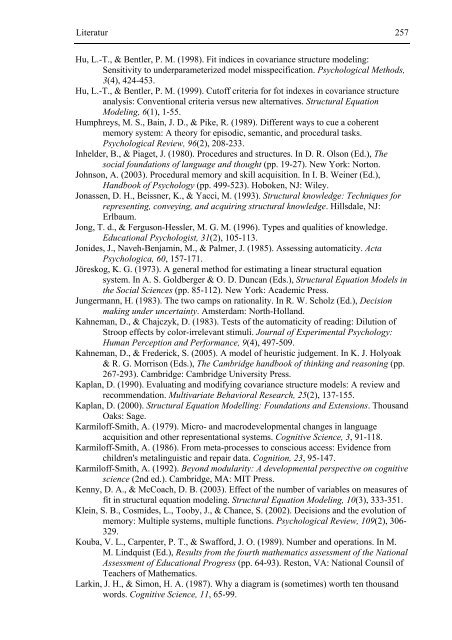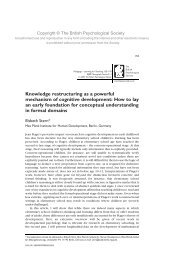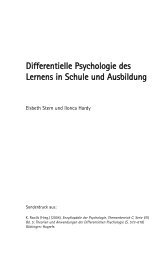Konzeptuelles und prozedurales Wissen als latente Variablen: Ihre ...
Konzeptuelles und prozedurales Wissen als latente Variablen: Ihre ...
Konzeptuelles und prozedurales Wissen als latente Variablen: Ihre ...
Erfolgreiche ePaper selbst erstellen
Machen Sie aus Ihren PDF Publikationen ein blätterbares Flipbook mit unserer einzigartigen Google optimierten e-Paper Software.
Literatur 257<br />
Hu, L.-T., & Bentler, P. M. (1998). Fit indices in covariance structure modeling:<br />
Sensitivity to <strong>und</strong>erparameterized model misspecification. Psychological Methods,<br />
3(4), 424-453.<br />
Hu, L.-T., & Bentler, P. M. (1999). Cutoff criteria for fot indexes in covariance structure<br />
analysis: Conventional criteria versus new alternatives. Structural Equation<br />
Modeling, 6(1), 1-55.<br />
Humphreys, M. S., Bain, J. D., & Pike, R. (1989). Different ways to cue a coherent<br />
memory system: A theory for episodic, semantic, and procedural tasks.<br />
Psychological Review, 96(2), 208-233.<br />
Inhelder, B., & Piaget, J. (1980). Procedures and structures. In D. R. Olson (Ed.), The<br />
social fo<strong>und</strong>ations of language and thought (pp. 19-27). New York: Norton.<br />
Johnson, A. (2003). Procedural memory and skill acquisition. In I. B. Weiner (Ed.),<br />
Handbook of Psychology (pp. 499-523). Hoboken, NJ: Wiley.<br />
Jonassen, D. H., Beissner, K., & Yacci, M. (1993). Structural knowledge: Techniques for<br />
representing, conveying, and acquiring structural knowledge. Hillsdale, NJ:<br />
Erlbaum.<br />
Jong, T. d., & Ferguson-Hessler, M. G. M. (1996). Types and qualities of knowledge.<br />
Educational Psychologist, 31(2), 105-113.<br />
Jonides, J., Naveh-Benjamin, M., & Palmer, J. (1985). Assessing automaticity. Acta<br />
Psychologica, 60, 157-171.<br />
Jöreskog, K. G. (1973). A general method for estimating a linear structural equation<br />
system. In A. S. Goldberger & O. D. Duncan (Eds.), Structural Equation Models in<br />
the Social Sciences (pp. 85-112). New York: Academic Press.<br />
Jungermann, H. (1983). The two camps on rationality. In R. W. Scholz (Ed.), Decision<br />
making <strong>und</strong>er uncertainty. Amsterdam: North-Holland.<br />
Kahneman, D., & Chajczyk, D. (1983). Tests of the automaticity of reading: Dilution of<br />
Stroop effects by color-irrelevant stimuli. Journal of Experimental Psychology:<br />
Human Perception and Performance, 9(4), 497-509.<br />
Kahneman, D., & Frederick, S. (2005). A model of heuristic judgement. In K. J. Holyoak<br />
& R. G. Morrison (Eds.), The Cambridge handbook of thinking and reasoning (pp.<br />
267-293). Cambridge: Cambridge University Press.<br />
Kaplan, D. (1990). Evaluating and modifying covariance structure models: A review and<br />
recommendation. Multivariate Behavioral Research, 25(2), 137-155.<br />
Kaplan, D. (2000). Structural Equation Modelling: Fo<strong>und</strong>ations and Extensions. Thousand<br />
Oaks: Sage.<br />
Karmiloff-Smith, A. (1979). Micro- and macrodevelopmental changes in language<br />
acquisition and other representational systems. Cognitive Science, 3, 91-118.<br />
Karmiloff-Smith, A. (1986). From meta-processes to conscious access: Evidence from<br />
children's metalinguistic and repair data. Cognition, 23, 95-147.<br />
Karmiloff-Smith, A. (1992). Beyond modularity: A developmental perspective on cognitive<br />
science (2nd ed.). Cambridge, MA: MIT Press.<br />
Kenny, D. A., & McCoach, D. B. (2003). Effect of the number of variables on measures of<br />
fit in structural equation modeling. Structural Equation Modeling, 10(3), 333-351.<br />
Klein, S. B., Cosmides, L., Tooby, J., & Chance, S. (2002). Decisions and the evolution of<br />
memory: Multiple systems, multiple functions. Psychological Review, 109(2), 306-<br />
329.<br />
Kouba, V. L., Carpenter, P. T., & Swafford, J. O. (1989). Number and operations. In M.<br />
M. Lindquist (Ed.), Results from the fourth mathematics assessment of the National<br />
Assessment of Educational Progress (pp. 64-93). Reston, VA: National Counsil of<br />
Teachers of Mathematics.<br />
Larkin, J. H., & Simon, H. A. (1987). Why a diagram is (sometimes) worth ten thousand<br />
words. Cognitive Science, 11, 65-99.





